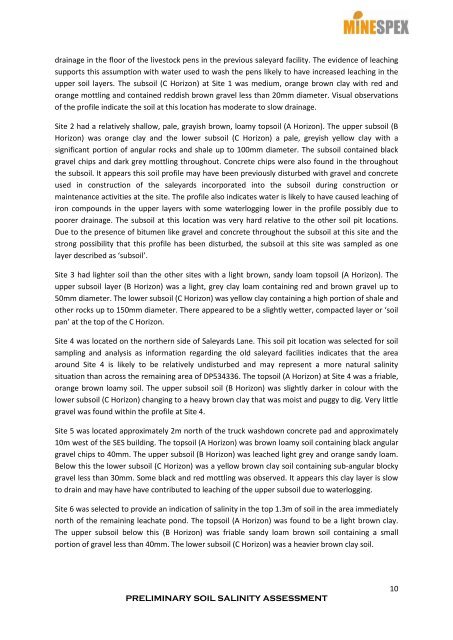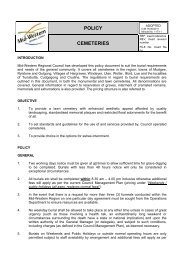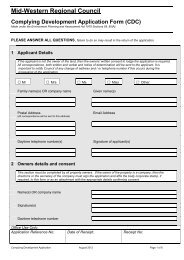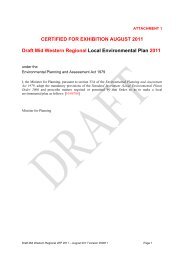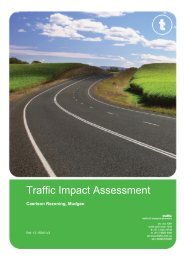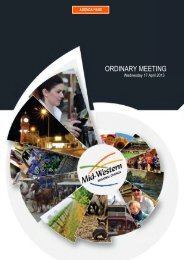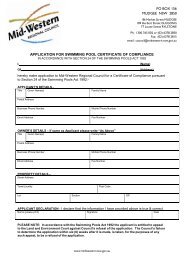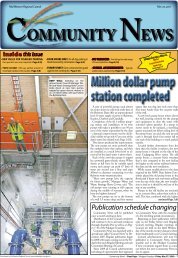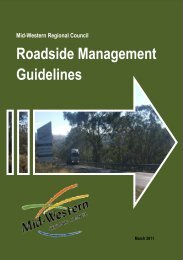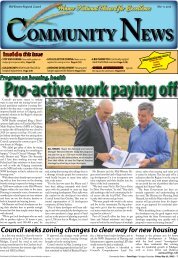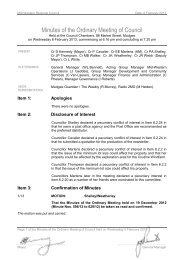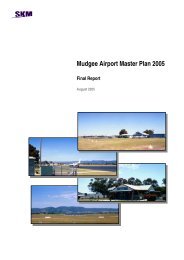preliminary soil salinity assessment - Mid Western Regional Council
preliminary soil salinity assessment - Mid Western Regional Council
preliminary soil salinity assessment - Mid Western Regional Council
Create successful ePaper yourself
Turn your PDF publications into a flip-book with our unique Google optimized e-Paper software.
drainage in the floor of the livestock pens in the previous saleyard facility. The evidence of leachingsupports this assumption with water used to wash the pens likely to have increased leaching in theupper <strong>soil</strong> layers. The sub<strong>soil</strong> (C Horizon) at Site 1 was medium, orange brown clay with red andorange mottling and contained reddish brown gravel less than 20mm diameter. Visual observationsof the profile indicate the <strong>soil</strong> at this location has moderate to slow drainage.Site 2 had a relatively shallow, pale, grayish brown, loamy top<strong>soil</strong> (A Horizon). The upper sub<strong>soil</strong> (BHorizon) was orange clay and the lower sub<strong>soil</strong> (C Horizon) a pale, greyish yellow clay with asignificant portion of angular rocks and shale up to 100mm diameter. The sub<strong>soil</strong> contained blackgravel chips and dark grey mottling throughout. Concrete chips were also found in the throughoutthe sub<strong>soil</strong>. It appears this <strong>soil</strong> profile may have been previously disturbed with gravel and concreteused in construction of the saleyards incorporated into the sub<strong>soil</strong> during construction ormaintenance activities at the site. The profile also indicates water is likely to have caused leaching ofiron compounds in the upper layers with some waterlogging lower in the profile possibly due topoorer drainage. The sub<strong>soil</strong> at this location was very hard relative to the other <strong>soil</strong> pit locations.Due to the presence of bitumen like gravel and concrete throughout the sub<strong>soil</strong> at this site and thestrong possibility that this profile has been disturbed, the sub<strong>soil</strong> at this site was sampled as onelayer described as ‘sub<strong>soil</strong>’.Site 3 had lighter <strong>soil</strong> than the other sites with a light brown, sandy loam top<strong>soil</strong> (A Horizon). Theupper sub<strong>soil</strong> layer (B Horizon) was a light, grey clay loam containing red and brown gravel up to50mm diameter. The lower sub<strong>soil</strong> (C Horizon) was yellow clay containing a high portion of shale andother rocks up to 150mm diameter. There appeared to be a slightly wetter, compacted layer or ‘<strong>soil</strong>pan’ at the top of the C Horizon.Site 4 was located on the northern side of Saleyards Lane. This <strong>soil</strong> pit location was selected for <strong>soil</strong>sampling and analysis as information regarding the old saleyard facilities indicates that the areaaround Site 4 is likely to be relatively undisturbed and may represent a more natural <strong>salinity</strong>situation than across the remaining area of DP534336. The top<strong>soil</strong> (A Horizon) at Site 4 was a friable,orange brown loamy <strong>soil</strong>. The upper sub<strong>soil</strong> <strong>soil</strong> (B Horizon) was slightly darker in colour with thelower sub<strong>soil</strong> (C Horizon) changing to a heavy brown clay that was moist and puggy to dig. Very littlegravel was found within the profile at Site 4.Site 5 was located approximately 2m north of the truck washdown concrete pad and approximately10m west of the SES building. The top<strong>soil</strong> (A Horizon) was brown loamy <strong>soil</strong> containing black angulargravel chips to 40mm. The upper sub<strong>soil</strong> (B Horizon) was leached light grey and orange sandy loam.Below this the lower sub<strong>soil</strong> (C Horizon) was a yellow brown clay <strong>soil</strong> containing sub-angular blockygravel less than 30mm. Some black and red mottling was observed. It appears this clay layer is slowto drain and may have have contributed to leaching of the upper sub<strong>soil</strong> due to waterlogging.Site 6 was selected to provide an indication of <strong>salinity</strong> in the top 1.3m of <strong>soil</strong> in the area immediatelynorth of the remaining leachate pond. The top<strong>soil</strong> (A Horizon) was found to be a light brown clay.The upper sub<strong>soil</strong> below this (B Horizon) was friable sandy loam brown <strong>soil</strong> containing a smallportion of gravel less than 40mm. The lower sub<strong>soil</strong> (C Horizon) was a heavier brown clay <strong>soil</strong>.PRELIMINARY SOIL SALINITY ASSESSMENT10


